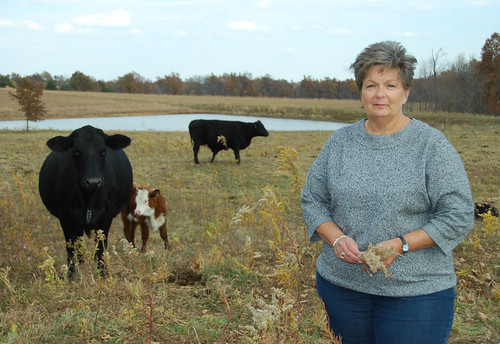
When Ann Whitehead acquired 100 acres of agricultural land near Wellsville, Mo., it gave her the opportunity to fulfill her dream of raising cattle. Since then she has been taking advantage of technical and financial assistance from USDA’s Natural Resources Conservation Service (NRCS) to ensure that the land will be productive for future generations of people who might share her dream.
“I grew up on a farm, but I was more in charge of the chickens,” Whitehead said. “Raising cattle is something I always wanted to do, so I told my kids ‘I’m not getting any younger, and I’m going to do it.’”
Whitehead took advantage of the Environmental Quality Incentives Program (EQIP) that provides funding for beginning farmers, ranchers and forest landowners associated with planning and implementing conservation measures.
Whitehead started with a small herd and has built the cow and calf operation from there. With a conservation plan, the cattle are moved regularly within a rotational-grazing system featuring 17 paddocks of warm-season grasses and legumes. The paddocks are separated by solar-powered, electric fencing that were financially assisted through EQIP.
Thirty acres include eastern gamagrass and 30 acres include a mixture of Indian grass and big bluestem. Another 10 acres are in fescue and the remaining in woodland. The cattle get water from a limited access at a pond and also at six other points where water is piped from the pond to hydrants and tanks.
Whitehead says the rotational-grazing system makes managing the herd easier and also allows her to keep more cattle. Management intensive rotational grazing systems like Whitehead's maximize the forage base because cattle are kept in one of the small pastures for a few days before being moved to another one.
While they are in a paddock, the cattle are forced to graze the whole area. By not allowing the cattle to overgraze one area of a larger pasture while neglecting others, the plants are healthier and the nutrition-rich animal waste is more evenly distributed. The plants also receive a beneficial rest period when cattle are in other paddocks.
“I went to some meetings, and all of the people who had switched to rotational grazing said the cattle handled so much better and that they performed better,” Whitehead said. “And the grass goes so much farther, which is important because I would like to get away from feeding so much hay.”
In addition to farming, Whitehead works as a technician with the Montgomery County Soil and Water Conservation District. In that capacity she works closely with other landowners and with NRCS employees.
She says that experience has taught her well that rotational grazing and other management techniques designed to protect natural resources work. And she is grateful for EQIP, and other state and federal programs that provide technical and financial assistance.


